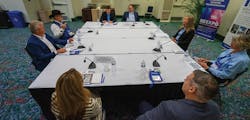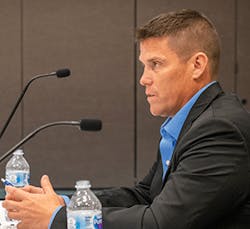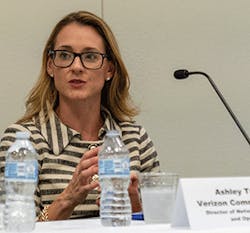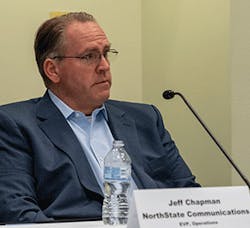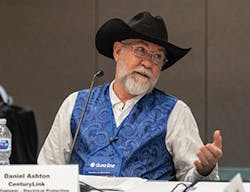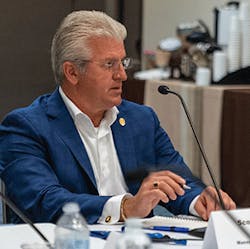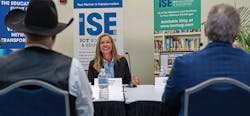ICT Visionaries Live Roundtable Highlights
Network Executives Gathered at ISE EXPO 2019 Share Pain Points and Passions —
While you couldn’t be a part of our closed-door roundtable event, we want to give you a peek into 2 of the many topics our ICT Visionaries explored. After you read their insights, think about what you, or someone you know, could add to this discussion.
Then, consider nominating someone extraordinarily good at what they do for the ICT Visionaries 2020 program. Email me ([email protected]) with your recommendations.
The ICT Visionaries attending ISE EXPO 2019 Roundtable:
• Daniel Ashton, Senior Engineer – Electrical Protection (ICEP), CenturyLink
• Scot Bohaychyk, Manager, Product Marketing, Clearfield
• Jeff Chapman, EVP, Operations, NorthState Communications
• Ben Goth, Vice President of Network Services, TDS Telecom
• Ashley Travers, Director of Network Engineering and Operations, Verizon
Hear what Scot Bohaychyk of Clearfield says about the future of fiber connectivity.
Topic: NETWORK EVOLUTION PAINS
Sharon Vollman, ISE Magazine: What is your biggest pain point across the wireline and wireless networks? How can the industry help solve it?
Ben Goth, TDS Telecom: Nobody has any pain. [laughter]
Ashley Travers, Verizon: Nope. No pain. [laughter]
Ben Goth, TDS Telecom: We face quite a few pain points at TDS. We keep running into inconsistencies across multiple pole owners, networks, and municipalities, in the way they will allow construction or permitting. That causes a significant amount of delay, additional costs, and the inability to proceed on a reasonable schedule. So, it’s hard to keep timelines and to deliver things we commit to when other groups we partner with have different desires for timelines or outcomes. That’s for sure one of our major pain points over the last several years.
ISE: Will One Touch Make Ready, or OTMR, help?
Ben Goth, Vice President of Network Services, TDS Telecom
Ben Goth, TDS Telecom: I think the FCC ruling was a good step, because it puts together some standards associated with the amount of time the pole companies have to deal with us and how timely they should respond. However, there’s nothing in the order that says what if they don’t adhere to the timing.
While I think it’s a good step in the right direction, there’s still nothing that can force those companies to do anything on a specific timeline. And we’ve had situations where they only have one person, or limited staff, taking the applications and been told, "The company can only process so many of these applications at a time. And, that there is no plan to add staff to process the influx of applications. So you can send in as many as you want, but you’ll only get back as many as can be processed by the available staff, at the pace they can get them completed."
We run into that all of the time. I don’t hold it against them. Because now that deploying fiber is ramping up from service providers, overbuilders, and wireless companies, the municipalities are like, "Wait! This is too much. We didn’t have this in our budget."
Let’s be honest. If we plan to do underground construction, it negatively impacts their locating costs. They say, "We didn’t budget for all this locating, and you’re breaking us." So, they’re not real inclined to do things quickly. At times, we’ve asked, "Hey, how much staff can you add to help us go faster?" They respond by saying they have all the staff they want.
In addition, there’s enough public stir about 5G that every municipality wants to be involved with what can be put in the right-of-way and what it needs to look like.
For example, we’re located where there’s a lot of snow and the ground freezes. In order for us to have a network that we can support over the winter, we have access points above ground-in pedestals. Recently, a number of residents in one community decided they don’t want those peds in the right-of-way which happens to be in their yards. They want the access point flush mounted. But, they don’t understand what happens if there is a problem with the network during the winter months and we cannot fix or restore service to customers.
Daniel Ashton, CenturyLink: And if they call with a problem in the winter, you can’t really say, "Sorry. Call me in the spring."
Scot Bohaychyk, Clearfield: Exactly.
Ben Goth, TDS Telecom: Or, we have to get out the warming blankets and hope the hand hole isn’t filled with water and entirely frozen.
Daniel Ashton, CenturyLink: Then your maintenance costs go through the roof. It’s fascinating. For years, it was normal for residents to see a pedestal or a transformer. Now, they don’t want to see anything.
Ben Goth, TDS Telecom: What we’re also running into is the reality that there’s already a copper ped there for cable and a copper ped there for phone. Now we want to put in a fiber ped, and residents don’t always want a third one.
Ashley Travers, Director of Network Engineering and Operations, Verizon
Ashley Travers, Verizon: It’s interesting and comforting to hear these stories. We are all in the same situation where we’re trying to work through applications and the lack of response is hindering our progress. In addition, it forces us many times to go underground, which costs us more. We all thought that aerial fiber was the way for us and, clearly, it’s been a challenge.
Earlier in our conversation we spoke about working with our manufacturing partners to help us solve some field problems. One particular example is that many municipalities don’t want big handholes. Thankfully, our partners have been very adaptable to make products that are working for these municipalities. That’s helping us evolve our fiber network build program in and out of franchised areas for Verizon. That’s definitely a key to our success.
Ben Goth, TDS Telecom: I think we need more vendor input on these issues.
Ashley Travers, Verizon: We need bigger fiber. We need smaller handholes. And we can’t bend it, so we’re in need of someone to figure that out for us. [laughter]
Daniel Ashton, CenturyLink: That collaboration is critical. I deal with Verizon, AT&T, and other providers, via the national standards bodies. We all acknowledge that the only difference between any of us are the logos on our shirts. We all face the same issues, the same problems, and the same heartburn.
Jeff Chapman, EVP, Operations, NorthState Communications
Jeff Chapman, NorthState Communications: One of the biggest pain points I’m having in my region of the country is deployment itself. Most providers today have the same goal: bring broadband to everyone. But the challenge is to execute it and to do it in a professional manner.
Given the historical disruption that occurred along with fiber cuts and underground damages, municipalities are pushing back now. They’re saying, "No more!" We’ve even had instances where we are not allowed to build if the city’s underground utilities are on either side of the road.
That’s a challenge for sure. I wish we all would be more collaborative and realize that we are competitors, but we can also be customers to each other. Our company has laid thousands of miles of fiber, and I will gladly sell it! Save your capital; there’s no need to overbuild me. Buy it from me. It saves a lot of time and a lot of energy.
Ashley Travers, Verizon: This brings us to the people part of the challenge. Today’s C&E teams have to be technical. But, they also must be people-oriented and good communicators. I expect them to be out there with the municipalities, building relationships.
Soft skills can be game-changing. It matters when our teams have worked hard to be on a "text basis" with their counterparts at the munis. It’s really the only thing we can do organically to help us get where we need to be as fast as we need to be.
Topic: YOUR TAKE
Daniel Ashton, Senior Engineer – Electrical Protection (ICEP), CenturyLink
ISE: Share one problem or challenge that you are passionate about solving for the ICT Industry.
Daniel Ashton, CenturyLink: Grounding and bonding and network protection are my passions; they are critically important to the network. That’s why I’m on a mission to get all the various standards bodies to work the same across all the standards. It’s tricky because there are so many variations. I’m trying to get parity across the board for everybody. So, when you go to a TIA standard, it’s going to tell you pretty much the same thing that an ATIS standard will or an IEEE standard or the European standard.
Ashley Travers, Verizon: My passion is related to the human element for our organization, specifically for outside plant construction. I’m aggressively trying to find more women and younger people to bring into this part of the business.
I had to build my team from the bottom up. Not only did I have to find market leaders, engineers, and project managers, I had to find those who possess superior communication skills and project-management skills. Those folks are winning for us with productive relationship-building.
A program that’s helping in this area is called the WiNTERN program. Last year, I had the opportunity to lead it for our organization. We bring in college students for the month of January before they go back to college. This past year, we recruited young women studying IT, Engineering, and Computer Science, as well as English and History. They came to Verizon for 3 weeks to complete a project together. At the end, they presented to our Senior VP and our leadership team.
I believe these efforts are critical to building a bench full of diverse talent that’s going to help our organization get where we want to be faster.
Ben Goth, TDS Telecom: We also have a pretty robust intern program that has brought people with various backgrounds into the company. They’ve interned successfully in IT, Network Services, Finance or other areas. Many have been hired after those experiences.
Jeff Chapman, NorthState Communications: We work with one of the local universities on our internship program. We take 3-4 people and make them employees who work about 10-20 hours a week while they are in school. They’re paid year-round.
The objective is twofold. One is to educate them about what we do. The second is to cultivate them to work for us. It’s a successful program for sure; but also a work in progress. Next year, we’re going to recruit a group of people with vocational skills because we need both fiber splicers and technicians.
Scot Bohaychyk, Manager, Product Marketing, Clearfield
Scot Bohaychyk, Clearfield: Since I came up through OSP construction, I look at how the network grows and changes. And if you look at fiber in general, it’s just plumbing. We tend to want to over-complicate it. It’s just putting 2 pieces together, and it has to flow. That’s all it has to do.
So, within my own company, my passion is to simplify that piece of the network. Service providers should be able to install all the high-count fiber you want. But when you get right down to the last piece and that final connection, it’s the most difficult thing to do.
For example, we need to push the industry to standardize on connectors. There are proprietary connectors, and that’s great for the company that’s manufacturing them but it’s horrible for the industry. So, if you can standardize connectors, service providers have choices of multiple vendors. And it gives you a standard across the industry that can help us ALL progress as fast as we need to for 5G and beyond.
Jeff Chapman, NorthState Communications: My passion is sparked when I’m told "It can’t be done." Because with today’s technology, anything can be done. You just have to think outside the box. And with IP and 5G, we’re seeing that box going away. The important thing is to create teams that are nimble enough to be able to work with that. You have to adapt. And if you don’t, it’ll be hard to survive in this environment.
I want to share a story that exemplifies this. There was a person who applied for a technician’s job but had absolutely no background in the industry and knew nothing about telecom. The hiring person gave me his name and number but also said, "We don’t think he’s the right guy. Still there’s something about him. We’d like you to talk to him."
I was traveling at the time and not far from him, so I gave him a call. I said, "Though I’m in your area, I can’t get together and meet. So, let’s talk on the phone."
He eagerly replied, "Where are you at? I’ll come to you."
I said, "I’m about an hour-and-a-half away."
And he said, "I’m on my way."
He was an insurance salesman, had a military background, and wanted to go into telecom. He came in, sat down and we got to know each other a little bit. After a short time, he said, "I don’t know anything about telecommunications, but I will give you 110% if you will just take a chance on me."
After he left, I called the gentleman who was going to hire him, and I said, "You know, I like the guy. I don’t know why. He is not the fit we need, but I like him."
We hired him. He went on to educate himself on everything possible and became a rising star. The thing that resonated with me was his attitude.
As a result, I’ve put this comment in my vocabulary for all of my Directors and VPs: I would hire for attitude over aptitude any day of the week.
ISE Editor, Sharon Vollman, enjoys hosting the ICT Visionsaries Live each year at ISE EXPO. Consider nominating someone extraordinarily good at what they do for the ICT Visionaries 2020 program.
Email: [email protected] with your recommendations.
About the Author
Sharon Vollman
Content Ambassador for ISE EXPO
Sharon Vollman is the Content Ambassador for ISE EXPO. She is passionate about collaborating with thought leaders, SMEs and hard-working doers who design, plan and deploy ultra-reliable broadband networks. Vollman is committed to creating a variety of educational offerings for ISE EXPO attendees that inspire them to connect every U.S. citizen with the broadband networks we all want for our children and grandchildren.
Vollman has created educational partnerships with Broadband Service Providers including AT&T, Verizon, Lumen, Frontier Communications and others. She has covered the telecom industry since 1996.
